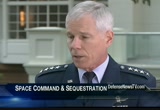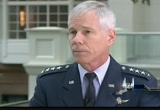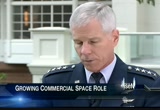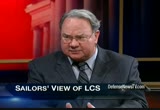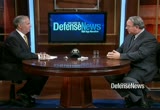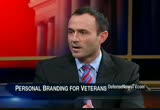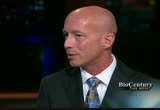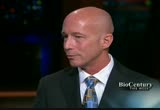tv Today NBC September 30, 2012 8:00am-9:00am EDT
8:00 am
captions by: caption colorado, llc (800) 775-7838 e- mail: mail: his week in mail: his week in defense news. muradian. the navy just commissioned its third littoral combat ship. we'll get an update on the controversial 55-ship program. >> plus, helping veterans get better jobs. a new plan from the u.s. chamber of commerce. but first, an exclusive interview with the chief of u.s. air force. space command general william shelton. few commanders are more operationally integral to all arms of u.s. warfighting than the air force space command that develops, launches, and operates the constellations of satellites and ground systems that make possible critical global services from gps, reconnaissance, missile warning, weather communications, or tracking orbiting spacecraft and debris. but developing satellites,
8:01 am
launching them, and operating them for long periods of time is expensive business at a time when demand for space-based assets for everything from reconnaissance, surveillance communications, and moving massive amounts of data is soaring. so shelton is leading efforts to cut costs by increasingly leaning on commercial space suppliers. we caught up with general shelton at the air force association's annual conference near washington, d.c. i asked him how sequestration will impact the command so important to global capabilities. >> it's a very good question. we don't know. sequestration is clearly a meat ax approach to the problem of deficit reduction. we believe there's a prioritization scheme that needs to take place. that is overcome by sequestration targets which force us into every program, not just the ones that you might identify as the priorities to go after but every program. in space, and in cyber, too,
8:02 am
foundational capability to everything we do, full people truck operations from humanitarian to full scale war. we're going to depend on capability. taking 10% out of that, you don't know where you would bring it. >> have you given consideration into what are the considerations to mitigate that risk as much as possible? >> we have not. by direction we have not because we believe that this is absolutely the wrong approach to the problem. so if you're looking at space capability, for example, would you give up gps capability, global coverage? would you give up missile warning capability global coverage? it's either a one or a zero here if you want to maintain global capability. >> obviously, you guys have key priorities, programmatic and otherwise. what are going to be the top priorities for, say, the next five years? >> we did celebrate our 30th year and we're proud of our accomplishments in the past 30 years, but we think we've got a
8:03 am
very bright future ahead in the next 30 years. our priorities will it into be supporting the joint war fighter, to getting control on the cost of space programs. i think we've been successful in that. i focused strongly on that in the first year and a half i've been in this job. over the next year, the third priority will be normalizing and operationallizing cyberspace. getting that cyber capability, getting cyber operations to the place where their operations and space operations are in the air force today. >> i want to talk a little about reducing space costs a little bit later in the program, but one of the things i want to start off with is space situational awareness. there is a lot of stuff in orbit that we don't know as much about as we would like. there are space grafts up there that aren't intersecting or things up there that are intersecting orbits with our important spacecraft that has been a concern over the last few years. knowing what's up there is more important than ever. where are we in the process of improving our ability to see what's up there, identify it as a potential threat, and as well
8:04 am
as hardened spacecraft if necessary given that, you know in a future conflict there could be a kinetic aspect to space that hasn't been? >> if space is foundational to everything we do, s.s.a., space situational awareness is absolutely foundational to everything we he do in space. so it is critical to our national security that we're as good as we possibly can be in space situational awareness. the things that we're doing to improve our capability, we're going to build a new sensor called a space spence which will give as much -- better capability for smaller objects and a much more volume capability of things that are in lower orbit. we're increasing our capability to see out to geo synchronous orbit with new telescopes. we're building a new system in our joint space operations center which will have much better computational power, have the ability to integrate sensors into the formulation of
8:05 am
what's the traffic, if you will. we've got a tremendous problem with space debris in lower orbit. we've got a problem of increased traffic on orbit because of the number of nations putting capability into space. so this will continue to be a vexing problem for us, but we have plans to increase our capability. >> including for hardening of satellites from kinetic approaches? >> i don't think you'll see us go to hardening of satellites for that purpose. i think what you'll see us do is do our best to track objects in space, smaller and smaller objects in space so that if we need to maneuver our satellites out of the way, we can. >> let me go to the just shear demand side of the equation. over the past decade, we've become increasingly, the force in general, depending on space, not just for gps and navigational reasons but insaucial thirst for date that that it's bouncing up into space at some point or another so it's touching the space
8:06 am
realm. we're now shifting to asia much faster theater a whole new generation of aircraft, f22, joint strike fighter as well that are increasingly dependent for coms as well as space to distribute the data that they collect. what kind of bandwidth are we going to need in 0rd to support the force in the future and fully come to grips as to what the cost of that is going to be? >> i think the answer is this is all still under review. we are looking at commercial options. we're looking at dedicated military communications. we're looking at specific options, architectural options on protected communications. there's certainly a demand for strategic and tactical protected communications. there's also this incredible demand for just wide bandwidth capability. we will look at all of the options, run the business cases on these and look at the ride approach for the future. you are absolutely right there is an insatiable demand and
8:07 am
rightly so. we're in the information age here. the person with the best information wins. >> but part of the key to do that is to reduce launch costs at large. i mean, both not only launch costs but spacecraft costs. space ex has been the first company to, you know, commercial company to develop a satellite and put it into orbit on its own launch vehicle. what is this space business going to look like? how much more creative do we need to be to be able to fill some of these capabilities more quickly for less costs? >> i think there's several things that we think about here. first, on the launch in the launch realm, we're actively encouraging companies like space ex and others to be new entrants into the launch business. we've had a long existing relationship with united launch alliance. they've done incredible work. in fact, 100% operational launch rate success. we've just had our, i believe, 51st in a row in terms of
8:08 am
national security launches that have been successful. unprecedented record. in the history of space flight, you can't find a better record that be that. you don't find anything that's even close. so it's not au.o.a. is not performing well, but the costs are much higher than we would like. so we will encourage them, help bring them along, get them certified and allow them to bid on national security launches. on the spacecraft side, we're looking at maybe sufficient is good enough instead of exquisite. maybe we can go to smaller satellites. maybe we can disaggregate capabilities on big satellites and at least complicate an adversary's targeting problem. there are a number of things that we're doing here to not only reduce costs but also our resilience in the space domain. >> since the inception of space in military space, the focus really has been platforms to deliver certain affects, but that's fundamentally changing,
8:09 am
isn't it? how is it fundmentally changing? >> we have over the years developed specific capability on orbit that comes down into specific ground systems, it's processed in the specific ground systems and the data really doesn't go that much beyond those ground systems. it certainly doesn't get integrated with other capability for the most part. paradigm we want to move to is this is all about the data. turning that data into information in that information to knowledge. so as i see the future of air force space command it's about much more of an information focus from our command. so rather than seeing a satellite on orbit as a particular capability a particular missile warning sat late or a communications satellite, i'd rather see it as a data source and then i integrate all that data, infuse it, and present it as knowledge to a decisionmaker. >> does that mean, though, no fundamentally, it's going to be
8:10 am
an ultimate space cyber intelligence? >> from all different domains. as you bring in capability from air platforms becomes another note on the network. it becomes another data source, another sensor out there. ground sensors, ground-based information, cyber-based information. space-based information. integrate all this together and in this information age that's where we've got to go. >> coming up, an update on the navy's combat ship
8:12 am
the littoral combat ship is a major element of the navy's plan to goat size of its fleet and equip it with new capabilities. the navy is buying two classes of these relatively small warships that would serve as hosts for a rain of of modules tailoring them to hunt subs, find mines or other ships. one version is built by a team by lockheed martin and the other by aus it. a. l, usa. the 55-foot ship has been the subject of critics for being too small and too short on capabilities while progress on the mission modules has stalled. here to bring us up to speed on this important program is one of the only guys who's ridden on all three ships who doesn't work for the navy or one of the contractors. defense new's very own warfare reporter, the one, the only christopher p. cavas. welcome back to the show.
8:13 am
>> thanks. how is the overall program? >> this has been an acquisition and development program for 8, 10 years. at the moment it's starting now to really transition from the shipyards and planters and budgeteers into the fleet. the fleet now has three of these ships. they need to get these things running. they are starting to learn how to operate them. >> there was a whole series of incidents with engines and other systems and corroding and cracking. are we over that? do we fully understand what's going on with that? >> these are new ships. they are development ships, prototype ships. this isn't really the development. the ultimate production model is not what is in the fleet right now. they have teething problems and some issues. all ships have some issues. it's just like a car. you have to take care of things. you know, maybe perhaps because they're not really operating yet, people have focused a lot on these issues, but they don't seem to be major. >> let's take a look.
8:14 am
i mean, there are three ships now in the fleet. the forth one is on the way that's coming next year. two of them have been operating and have. out there and folks have been playing with them. one, the austal designed and the other one is the lockheed participaten version. what's the feedback that -- how are sailors responding? >> what the navy has done is take a close good look at the ships and really what they have. there was a big material inspection of the first ship. there were war games run to try to figure out how to operate them and how the navy will support them and sustain them is the word they used. there was a major study done earlier in the year by the navy from an operational point of view, how can we integrate the ships into the fleet? how's that going? it wasn't an assessment per se, it was an effort to find out what's wrong, where the problems are, what are the issues that we have to work
8:15 am
with. it's a well-run study. one reason it's classified is because it's not an assessment of the program. there's no evaluation of this is good, that's bad this is okay. it's not -- it's a question of what do we have to work on? >> sailors have been talking about the work load given it is a very small crew to save money and have cut down on the crew size on both of the ships. sailors have complained even to you that the work load is very high. is the navy working to work around that? >> the navy is exceptionally concerned about the work load on the ships. they have very small crews. everything about the ships was that they are small ships built to a tight budget. so they are very minimal. normally, when you have a ship, you have a number of people who operate the systems, but there's also a lot of people who maintain the systems, keep things working, repair them, keep them in functioning order. when you are out at sea, nobody's going to make a house call. >> right. >> you've got to get somebody on board who can fix something.
8:16 am
these ships have very small crews. 40 people is the core crew. it is a ship of operators. they don't have too many people to fix things. >> right. >> because of that, the effect on the crews is really extreme. so the navy's done a number of studies about manning, and they've determined, for example, that three days of low level operations on an l.c.s. equals three days of high-tempo operations. >> the key to the program are the mission modules you have to have the detachment aboard the ships, but they've been delayed. also, they are not proving to be as easily interchangeable. bring us up to speed. how serious a problem is this on the mine side and the surface module? >> the whole idea is this is a truck. you bring on equipment and you perform a certain mission when you've got this module of equipment on. so you have different missions and the warfare. they are all being developed in
8:17 am
different levels. right now, the one they need the fastest is the mine countermeasures system, but that's not operational, and it still won't be operational for three, four years. it's still in development. even once they feel it, it will start to ratchet up. there will be a demonstration deployment next year so they are putting together a package module if you will, of various components to demonstrate while they are out. >> this is the deployment coming up to singapore? >> that's right, next march. the first ship, the freedom. >> the fist of four will be operating on a assembling? >> this ship will do a demonstration deployment. this is a big deal. the ship right now is doing some maintenance. when they come out next month in october, they are going to . up next a new push to get veterans better sh
8:20 am
helping veterans get jobs has become a major concern for americans. political and business leaders have many programs to help do that including hiring our heroes by the u.s. chamber of commerce transitioning from military to civilian life. this year it's expanded its efforts with personal branding guides to help define who they are and what they bring to potential employers. kevin schmiegel a former marine lieutenant colonel is former vice president of the chamber of the commerce. sir, welcome to the show. >> thanks for having me. >> what does hiring our heros do and what does it do that other veterans organizations don't? >> i think hiring our heroes is the largest scale effort of its kind. if you look at what we're trying to do it's create a movement across the country. it is a nationwide campaign to help veterans and military spouses find jobs across
8:21 am
america. >> let's talk a little about the personal branding, which i this i is a tremendous idea, but something that i think your average marine, your deck plate sailor, your soldier doesn't think about? how do you guys put it down and what does it mean for the troops transitioning to find a job? >> sure. we've done 300 firing fairs across the country. every day, we see younger veterans, especially those under the age of 24 having difficulty explaining to employers what they did in the military. this is very simple. they have 90 seconds to give their elevator pitch, to talk about what makes them a better prospective employee than the next person that walks in the door that may have a college degree. this is about branding themselves as individuals. >> what are the keys to it that they should remember in the back of their mind? >> first and foremost, the tangible skills they learned in the military. taking the military occupation
8:22 am
and boiling it down to the technical thing these learned and explaining that to an employer. the second is the intangibles. listen, these are young men and women with leadership experience and management experience. they have an incredible work ethic and work well in team hesp in is what employers across america are looking for. it's not just the technical skills. lastly, they have a compelling story to tell. they've assimilated cultures around the world. they've traveled to far off places and lands and dealt with tribal leaders. they are incredible individuals. they just have to learn how to tell their story. >> in terms of telling the story, one of the folks who's been successful as an inspirational figure but also as a really dramatic branding in the most positive way, almost an exercise is former marine dakota meyer. he is now working with you guys. what does he bring to the program and what kind of a difference is he making out there? >> well dark cota myers is the
8:23 am
perfect spokesperson, right? we look across the landscape right now. post-9/11 veterans have 12% unemployment. those under the age of 24 have 29% unemployment nationally, and if you watch dakota, he's having his own evolutions on branding. what he brings to the table is very simple. dakotas with an infantryman. he was a scout sniper in the military. when he went to talk to employers for the first time, had he to learn that it wasn't just about pointing and shooting and communicating, it was about working well in teams, leading men, and operating in adverse conditions, challenging environments and adapting and overcoming. >> in about 15 seconds you have left what's next for you guys? >> we are looking to grow our program nationally, continue to expand our community efforts, but we're also looking at showing veterans where the jobs are and who is hiring. we're calling that the fast track program. >> and they should look on your
8:24 am
8:25 am
8:26 am
travel funding is always among the first casualties when budgets are cut. after gsa's conference scandal earlier this year, d.o.d. said it would review conference or other event costing more than $100 to attend. moving one general plus staff can cost that much dealing a potential blow to trade shows that justify their existence by putting executives and defense leaders together. exhibitors have been willing to pay the costs of these shows to make their case, persistence policies or more funding to a specific official while gathering intel and exchanging ideas. such shows are a remarkably
8:27 am
economic way to get a lot done in a short period of time. in an era of fiscal austerity, the need to communicate and exchange ideas is going up, not down. service leaders have an obligation to remain engaged but must better plan their leadership gatherings and trade events to maximize the value of each. the days of military tour tourism are all over. with every commander traveling around the world to attend every conference. one way to reduce conference and trade show costs is to follow the marines' lead. hold the show on a military base not a swanky hotel or conference center. the key is making sure we're not wasting money on travel you don't need at the expense of making trips that have real value. thanks for joining us for "this week in defense news." i'm vago muradian. you can watch this program online or e-mail me. i'll be back next week at the same time. until then, have a great week.
8:29 am
how will congress, industry and universities respond to the science funding squeeze? i'm steve usdin. welcome to "biocentury this week." your trusted source for biotechnology information and analysis. "biocentury this week." science is under stress as fiscal austerity forces governments to make tough decisions. last week we heard from n.i.h. director francis collins who oversees the world's largest medical research budget. > i've been been involved in this enterprise now for 30 years, and the pace of discovery is accelerating at really remarkable pace. it allows us to make things possible that we wouldn't have dreamed up a decade ago. at the same time, neither i nor anybody else who's been aen for a long time in biomedical research can remember a time
8:30 am
where the enterprise felt under such stress in terms of whether the resources will be there to allow these discoveries to continue to happen. >> colin said there ant any easy answers. n.i.h. is a critical part of the ecosystem but its work it only be furktly translated into medical progress if other parts are working properly existing more out of expiesing money will require universities and industries to change the way they operate. the back to school essay offered some suggestions. we noted that europe pays universities less for overhead and we challenged industry to commit itself to funding work that n.i.h. does not do very well. >> to continue the discussion today, we'll hear from daniel ford about how john hopkins university plans to cope with tight science funding. hop skins was the lead -- hopkins was the leading recipient of funding. it received grants worth $570 million. we'll hear industry's viewpoint from doug williams, a member of the leadership team of a company that discovered and
8:31 am
markets drugs for put cal schoar rows and -- multiple sclerosis and cancer. for an insider's perspective on congress' tick, we are joined by mike. i want to start with you. when you were in congress, you pushed for the n.i.h. budget doubling. you convinced newt gingrich this was a good idea to do. congress did it but after they finished doing it, they kind of took their eye off the ball and inflation adjusted terms, n.i.h. funding has gone down, has declined substantially since then. what happened? >> first i don't think -- i don't take credit for pushing newt beginning rich to do -- gingrich to do anything. you don't push gingrich. i think there was a period of time after all was completed with doubling the budget, you know, ten or so years ago, that the members of congress basically said hey, we doubled their budget. therefore, we're not going to give them as much in the next
8:32 am
few years as we did then. i think that's continued. i think there is also a problem, a disconnect, if you will, of an understanding by the members of congress, perhaps members of my own party, the republican party, in terms of the need for medical research, the need for the basic research that's paid for in large part by the government to lead to the transactional research and the development of the necessary preventives and cures to diseases out there. i think we need to make sure the story is told better. i wish it was a major part of the various campaigns that are going on in this country now because there is justifiable cause to make sure that we are funding research properly. >> dan, the reality is that n.i.h. budgets in real terms have gone down. if the see cress traition -- sequestration happens, they're going to go down a whole lot
8:33 am
next year. what do institutions like hopkins, what's your response to that? what can you do, what should you do to squeeze more out of the funds that you've got? >> on a very sort of day-to-day level or the micromanagement, it's very hard to know because we don't know what the sequestration is going to mean in terms of how quickly the funds go down. does it mean new grants? does it mean continuing grants? we're going to change what we do directly and will be difficult. what we begin to do like anything is we try to look for some efficiencies across -- that we find ways to do the same studies or produce the same amount of research for less resources. but that's very tough because most of the research budgets, what we're trying to accomplish are already kind of a razor thin margin. sometimes we worry we're not -- we don't have enough funding to really do the study at the highest quality we want to begin with. the other thing is clearly
8:34 am
preserving the faculty that really work as researchers. i think for the first time we're seeing our faculty saying whatever funds we have, we need to use for salary support, particularly to keep young investigators involved. much less saying let's buy in a new technology the latest machines and equipment. >> what are your ideas? what n.i.h.s, universities, industries should do, can do with what they've got? >> the reality is we're living in a constrained environment right now. i'll start from a position that i think public funding of research is an incredible important thing that needs to be strengthened in this country. there's a lot of dividends that it pays to a variety of constituencies. you can look at the economy. there are jobs that get created through n.i.h. funding. we've created an industry, bite crow tech industry that -- the biotech industry that i think leads the world here in america
8:35 am
because of the basic funding at the n.i.h. but i do think as dan says, some efficiencies need to be looked at. there are probably ways in which overhead costs in particular need to be looked at to try to squeeze perhaps some dollars out of that portion of grant support and put it into the actual doing of the science, if you will. it's a difficult question because the pie is getting smaller and the costs of doing research are going up. i think one of the solutions is clearly the interaction between companies like mine and companies across the biotech and pharma industry in supporting the kind of research we all know is very important to essentially fuel the engine of drug development over the long haul. >> i want to get back later in the show about the idea of deliberations between industry and academia. one of the things that doug mentioned and was mentioned in my show with mr. collins is cutting the overhead costs of
8:36 am
universities. what would be your response to that? >> it really depends on what we mean by overhead. i will say this. if you look at large academic institutions like us with hundreds of individual n.i.h. grants, the way the system is set up is you -- it's an individual investigator doing an individual application that works with a single project officer on how to do that study. there's very -- there's not many mechanisms to talk about infrastructure support across a range of studies. >> let's pick that up when we come back. n.i.h. funding has lost ground in place since 2003. now budget sequestration will impose more severe cuts. here are the facts.
8:37 am
8:38 am
8:39 am
what would sequestration mean for science? we're talking with doug williams, mike castle and daniel ford. you were talking about the overhead and how much options there are for cutting overhead costs and using that money for research. >> i would think more specifically as we do about how do we group infrastructure that's going to efficiently support a wide range of studies. the clinical translational science award that francis cool ridge and others at the n.i.h. -- collins and others have n.i.h., they are important centers that can provide resources that can help multiple investigative groups. but they are 3% of your n.i.h. budget. so it's hard to do a lot with
8:40 am
the 3% in terms of building infrastructure. i think we're going to have to look, you know, going forward what are those centralized services that can be provided more efficiently than when each individual research team tries to do it themselves. >> doug and mike action, -- mike, i want to bring you in here, one of the other things you alluded to are the shifting roles of industry. i was interested in the case of biogen, you're funding academic collaborations with harvard for very basic research, things that one would have thought in the past n.i.h. would have been doing. can you describe basically what you're doing and why. >> sure. we have actually made it a priority for us as a company to reach out to academic institutions and to fund some fairly basic research projects. the two that are disclosed so far, one is with harvard. the idea is to completely map all of the interactions between
8:41 am
the proteins within human cells. it's a rather large and ambitious project. it's already been done in fruit flies so we know we can do it. the reason we chose to do that is because it's important information. on a relative scale, it's relatively inexpensive to do that sort of work. i think that's one of the keys here is discovery research, if you compare that to clinical research, is relatively inexpensive. this was information that there are certain aspects of it that we know we can use to sort of rekindle some of the discovery efforts within our own company. but we want to see that information flow into the public domain. to harvard essentially owns the information. no scientist will publish on it. and that will fuel research work not just for our group but for a variety of groups for years to come i think. it's relatively inexpensive. >> do you think there's going to abswitch, a kind -- to be a switch, a kind of diversifying the source of funds?
8:42 am
>> i think every academic organization is going to have to look for sources of funding outside the n.i.h. while we all have concerns about conflicts of interest and -- i think academic institutions in the corporate world are finding ways to work through that. part of it out of necessity, part of it because we think that's how we work discoveries faster down the translational pathway and i think we can do it. of course the other place we're looking for funding are patient groups. we can't forget that the patient groups are the ones that are saying who is going to find that cure for my disease? >> and move quicker. mike, one of the things i think if you're looking at congress or anybody funding something, they want to get a sense of what they're getting for the money, an accountability. do you think members of congress have a sense of what they're getting for the money that's being invested in science and how tight it is, how difficult the situation is
8:43 am
now for basic research? >> i think the answer to that is no. when you're talking about medical research. and i believe that all of us have a responsibility, and that includes the universities, the private sector, n.i.h., whatever, to explain better exactly what medical research has produced in this country. it's an amazing record not only in terms of jobs but in terms of cures for people. i don't think members of congress understand that. i don't think the public necessarily understands how it happened. >> one of the things in going forward is to say what are the measures of productivity, what are the measures for the money that's being invested now? quickly, we have a little bit of time now, from dan, what are your ideas? how should the productivity of the money that n.i.h. invests in research be measured and be reported? >> well, it's very complex. i think we first have to start with that because you have to realize most of the discoveries, they start in little pleases and they add up to a cure -- pieces and they add up to a cure.
8:44 am
i think it starts with complexity but if you look at the broad trend of the health status of americans and the fact that when americans are healthy, they're wealthier because they can work more, i don't think there's any doubt that that trend continues. and it's fueled by the discovery turned into a product. >> we'll have to get to doug's answer when we come right back. we'll
8:46 am
now, back to "biocentury this week." what will sequestration deep budget cults mean to science and inning know vision? we're talking with mike castle. daniel ford and doug williams. one of the things we're talking about avoiding sequestration and about getting funding for n.i.h. in general is getting some kind
8:47 am
of accountability, some measures that congress and the public can know that if you put 10% more in, you're going to get x or you put 20% more in, you're going to get x? any comments on that, doug? >> it's a complex program. publicly funded science is so broad. there are metrics that we typically use in a corporate environment, a number of patents that are filed, technology licenses that are executed. those are really the commercialization faitz of the signs that's -- phase of the science that's been done. you can do some look-back and look at the public funded scientific initiatives done over the years. what was done for h.i.v. about $10 billion spent in the overall scheme of really turning that into a chronic disease now. avoiding about a trillion dollars worth of costs. so there's definitely a return on investment. there's a variety of different ways of calculating that. i'm not sure what the right one is but i think there's plenty of metrics we can use to
8:48 am
demonstrate the value of science. >> what are the kind of metrics that resonate in congress? >> i think one metric that resonates in congress is what doug has mentioned. i think the fact that there are diseases out there which have either been conquered in some way or another or extensions of life or betterment of life is extremely important. if you just look at longevity, for example. we're all living a lot longer now. maybe we're smoking less and our lifestyles are better but part of it is medicine, too. part of it is the things we take to reduce cholesterol or blood pressure or whatever it may be. these are very important developments. you can look at virtually any disease and somebody is working on it, the complex ones, diabetes, alzheimer's will be a while before they're resolved but as dan pointed out, if you can just make incremental process in those areas and the lives of those people, it's tremendous. somebody who understands they're living 20 years longer
8:49 am
and might not have lived if they had not taken certain medicines developed because of research, by god they ought to be all for it one way or another. >> another thing the drug development model is so clear that we tend to talk about new drugs produced and that's fine. but the n.i.h. funding is for broader initiatives than just that. one way you can think about it is, you know, have practice guidelines changed because of evidence produced by n.i.h. funding? have we discovered a biomarker that says this is a disease -- your form of the disease is going to be very chronic. does it need aggressive treatment? this is -- we've developed a new way to diagnosis this disease earlier that may change the course of the disease. >> that brings up an idea actually that something doug had quoted in the back-to-
8:50 am
school issue that biocentury wrote is generating this evidence. how much of the clinical work to generate that evidence should be done by industry and how much of it should be done by academia and how much should be done in partnership? you had an idea n.i.h. doesn't actually do a very good job of generating clinical evidence. >> it's probably not quite-- >> maybe overstating it. >> an overstatement i think. i do think that drug development and bringing new drugs to market is probably best done by the pharmaceutical industry. we're really sort of geared towards that. but i'd also say that we can't do that in the absence of the partnership that we have with the academic institutions or the physicians that we work with are at hopkins and other institutions around the world. the patients that participate in the clinical trial process. you know, it's very much an effort on the part of a number of constituencies, including
8:51 am
academic institutions, the pharma institutions as well as the patient themselves who are willing to put themselves in clinical trials. >> part of the question is there a way to confuse the clinical trial enterprise with more of a sense of urgency as mike mentioned with the h.i.v. , to get things done more quickly? >> well, i think that's a huge point that you make, that we need to find that out. in clinical trials, you know, it is a very complicated process, the number of people and stakeholders involved in that process. we need to have patients that trust us, are willing to enter into clinical trials. we need insurance companies that are willing to make it easier for us to decide what's paid for by the sponsor, what's paid for by the insurance companies for the associated care within it. we need doctors that are aware of and ready to put their energy into it. so it goes across the board in
8:52 am
8:54 am
let's get some final thoughts of making scientific progress in an era of austerity. >> there will be cuts. it's more than just n.i.h. when you're talking about scientific research, medical scientific research and you're talking about the cdc. you are talking about the fda and various others. it's a question of controlling what those cost reductions are going to be and emphasizing the importance of it. we need to get the message out
8:55 am
of the good that's been done and got that can be done. >> dr. williams? >> i would follow up on that and say that i think there's abundant evidence to say that publicly funded science has really transformed human health over the course of the last several decades. we've literally added decades to the lives of average citizens around the world through a variety of different scientific fish timps. its -- initiatives. it's worthy of public funding and i think there's abundant evidence to show that it does provide significant benefits for patients which ultimately is what this money is there for. it's to improve the lives of patients around the world. >> i would safe all the data shows that the public supports government funding of biomedical research. we've created a long-term partnership between academic health centers and the federal government to build up this creative and very innovative research establishment and if we lose funding, it will be
8:56 am
important cuts because we don't have a lot of flexibility. we talked about other sources but again at johns hopkins, 85% of our funding is from the federal government. >> we have just a minute left. very quickly for each one of you, what's one thing that universities, that industry, that government, that congress needs to do, can change to make things better to get more efficiency out of the money we're spending on science now? >> well, i would say from my level, providing a little bit more flexibility. as everyone says in terms of the funding, the funding pattern now is very dependent on individual studies. we need some way to be able to concentrate that funding which gives us an opportunity to be more creative in how we can improve the efficiency of the research process. >> i think it's continuing to expand the public/private partnerships that exist, the consortium type relationships around a particular disease and really focusing dollars and
8:57 am
creative minds around a particular problem. >> i agree with the flexibility. i think collaboration among the different entities involved with this is extremely important and telling the story, getting the story out of what medical research has done for the health of all of us in america and around the world. >> thanks. that's this week's show. i would like to thank my guests. i'm steve usdin and i'll see you next week.
226 Views
IN COLLECTIONS
WRC (NBC) Television Archive
Television Archive  Television Archive News Search Service
Television Archive News Search Service 
Uploaded by TV Archive on

 Live Music Archive
Live Music Archive Librivox Free Audio
Librivox Free Audio Metropolitan Museum
Metropolitan Museum Cleveland Museum of Art
Cleveland Museum of Art Internet Arcade
Internet Arcade Console Living Room
Console Living Room Books to Borrow
Books to Borrow Open Library
Open Library TV News
TV News Understanding 9/11
Understanding 9/11

